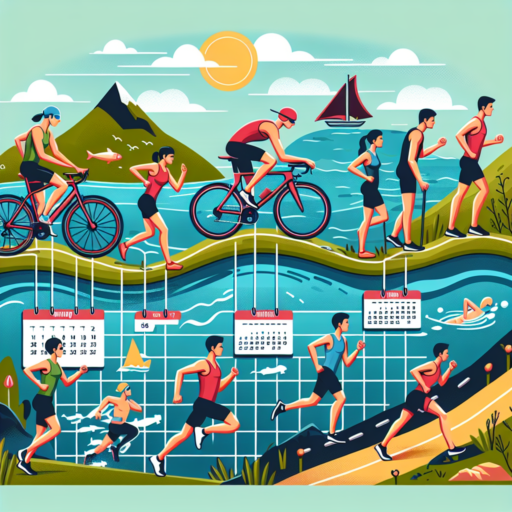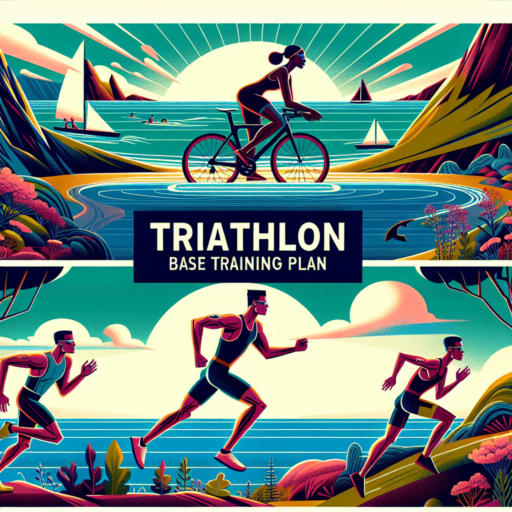Introduction to 12 Week Olympic Triathlon Training
Embarking on a 12-week Olympic Triathlon training plan is a monumental commitment that paves the path to accomplishing one of the most challenging endurance tests in the sports world. Aimed at both newcomers and seasoned athletes, this introductory guide lays the foundational bricks to what promises to be a transformative journey. Drawing from a blend of swimming, cycling, and running, the Olympic Triathlon demands not only physical prowess but also strategic planning and mental tenacity.
The essence of a 12-week training regimen is designed to systematically build your endurance, speed, and efficiency in all three disciplines. This period allows for a progressive increase in training volume and intensity, ensuring a gradual adaptation to the demands of the Olympic distance. The goal is to peak at the right moment, arriving at the starting line fully prepared without being overtrained or injured. Such a plan involves a meticulous balance of workouts, rest days, and nutrition strategies tailored to your individual needs and current fitness level.
Initiating this journey requires a baseline level of fitness, as the training will swiftly escalate in intensity. Therefore, a preliminary assessment of your swimming, cycling, and running capabilities is crucial. This not only helps in customizing your training plan but also sets realistic milestones throughout your preparation. Moreover, integrating strength and flexibility training into your routine plays a critical role in enhancing performance and reducing the risk of injury. Emphasis on technique, especially in the swim and run segments, can significantly improve efficiency and conserve energy, which is invaluable in a multi-sport event like the Olympic Triathlon.
Week-by-Week Breakdown of Your Olympic Triathlon Plan
Embarking on an Olympic triathlon journey is an ambitious challenge that combines swimming, biking, and running in a single event. A well-structured, week-by-week plan is crucial for building the endurance and strength needed, while ensuring your body has enough time to recover and adapt. This guide provides a breakdown of what each week might entail to help you cross the finish line successfully.
Phase 1: Building a Foundation
The initial weeks of your Olympic triathlon plan are focused on establishing a strong aerobic base across all three disciplines. During these weeks, workouts should concentrate on steady-state efforts, gradually increasing in volume. This phase often begins with shorter, more manageable sessions, approximately 30 minutes for each discipline, three times a week. As your body adapts, the duration and intensity of these sessions will slowly increase.
Phase 2: Increasing Intensity
Following the foundation phase, your plan will start to incorporate more intensive workouts. This includes interval training, hill repeats for biking and running, and pace work in the pool. The aim is to build your anaerobic threshold, making your body more efficient at utilizing oxygen and delaying muscle fatigue. It’s a critical phase for improving your speed and endurance, setting you on a path towards peak performance in all three segments of the triathlon.
The final stretch of your Olympic triathlon plan will integrate tapering, allowing your body to rest and repair before the event. It’s a time to reduce the overall training volume while maintaining some level of intensity, ensuring you’re rested, but still sharp, for race day. Remember, a successful triathlon is not just about how hard you train, but also how well you recover and prepare in the weeks leading up to the event.
Essential Gear for Your 12 Week Olympic Triathlon Preparation
Preparing for an Olympic triathlon is a challenging yet fulfilling endeavor, demanding not only discipline and training but also the right gear. Over the next 12 weeks, your preparation will span swimming, cycling, and running, each requiring specialized equipment to optimize performance and comfort. A strategic investment in essential gear can significantly enhance your triathlon experience, ensuring you’re well-equipped to tackle each discipline with confidence.
For the Swimming Segment, a high-quality wetsuit designed for triathlons is crucial for several reasons. First, it provides buoyancy, which can improve your swimming speed and reduce fatigue. Additionally, the right fit minimizes drag and keeps you warm in cold water conditions. Equally important are swimming goggles that offer clear, wide vision and a comfortable, leak-proof fit. Ensuring you have these items will set a solid foundation for your triathlon training.
Transitioning to Cycling, the importance of a reliable, lightweight triathlon bike cannot be overstated. Your bike should be an extension of your body, offering seamless integration for maximum efficiency and speed. A proper fitting session with a professional can make a significant difference in your comfort and performance. Accompanying your bike, a high-quality helmet that meets safety standards while ensuring ventilation and aero-dynamics is non-negotiable. Additionally, investing in a pair of bike shoes that click into your pedals will enhance your power transfer and overall cycling experience.
No se han encontrado productos.
Nutrition and Diet Tips for Triathlon Training Success
Embarking on a triathlon journey requires not only rigorous training but also a strategic approach to nutrition and diet. Understanding the relationship between what you eat and how it fuels your body can significantly enhance your training outcomes. Below are targeted nutrition and diet tips designed to propel triathlon training success.
Emphasize Carbohydrate Intake for Enhanced Energy
Carbohydrates are the primary fuel source for triathletes, playing a crucial role in sustaining energy levels during long and intense training sessions. Incorporating a variety of carbohydrates such as whole grains, fruits, and vegetables in your diet ensures a steady release of energy, keeping fatigue at bay. Prioritize complex carbohydrates like oatmeal, quinoa, and sweet potatoes for their slow-releasing energy properties and their nutritional value.
Don’t Underestimate the Power of Hydration
Hydration is a key element that often gets overlooked during the preparation for triathlons. Maintaining an optimal level of hydration is vital for peak performance and recovery. Aim to consume fluids consistently throughout the day, not just during training sessions. Incorporating electrolyte solutions or drinks can also help in replenishing the minerals lost through perspiration, preventing dehydration and the subsequent decline in performance.
Protein is an equally important component of a triathlete’s diet, aiding in the repair and growth of muscle tissue, which undergoes stress during training. Including a sufficient amount of protein from diverse sources like lean meats, fish, legumes, and dairy products can enhance muscle recovery and prepare your body for the next training session. Balancing your protein intake throughout the day, rather than consuming it in one large meal, can maximize muscle repair and growth.
Swimming Techniques and Drills for the Olympic Triathlete
For Olympic triathletes, mastering the art of swimming is crucial. With water being the first frontier in the triathlon, efficient swimming techniques and drills can set the tone for the remainder of the race. It’s not just about speed; it’s about preserving energy, maintaining a smooth stroke, and maximizing breath control. This section explores crucial techniques and drills tailored specifically for the challenges faced by Olympic triathletes in the swimming segment.
Enhancing Streamline Position
One essential technique for Olympic-level swimming is perfecting the streamline position. The objective is to reduce water resistance to a minimum, enabling faster and more efficient swimming. Triathletes can practice this by performing streamline kicks against the pool wall. This drill not only improves the streamline position but also strengthens core muscles, which are vital for maintaining stability in water. Incorporating flutter kicks in a streamlined posture further enhances the ability to maintain this position over long distances.
Optimizing Breath Control
Effective breath control is another cornerstone of successful swimming strategies for triathletes. It plays a pivotal role in endurance and energy conservation. A recommended drill is the 3-3-3 breathing pattern, where the athlete takes three strokes while breathing to one side, then three strokes breathing to the other side, followed by three strokes without breathing. This drill not only helps in improving lung capacity but also trains athletes to be comfortable with alternate breathing patterns, essential for adapting to varying race conditions.
Incorporating these techniques and drills into training routines can significantly impact a triathlete’s performance in the water. Focusing on drills that enhance streamline positions and optimize breathing can lead to substantial improvements, not just in the swimming segment, but in the overall triathlon performance. Regular practice, combined with expert coaching, can prepare an Olympic triathlete to face the challenges of the swim with confidence and proficiency.
Improving Your Cycling Speed and Endurance for the Olympic Distance
Enhancing your cycling speed and endurance is crucial when preparing for the challenging Olympic distance. Competing at this level requires not only determination but also a strategic approach to training. Here, we’ll dive into effective strategies that can significantly elevate your cycling performance, enabling you to achieve your best during the race.
Targeted Training Plans
To excel in cycling for the Olympic distance, a targeted training plan is indispensable. Incorporating interval training into your regimen can drastically improve your speed. These high-intensity efforts followed by periods of recovery allow your body to adapt to the stresses of fast-paced cycling. Equally important is endurance training, which involves longer, steady-state cycling sessions designed to build your stamina. Combining these two approaches ensures a well-rounded preparation focused on both speed and the ability to sustain it over the distance.
Nutrition and Recovery
Optimizing your nutrition and ensuring proper recovery are fundamental components that go hand-in-hand with your training. A focus on carbohydrate loading and protein intake can significantly enhance your energy reserves and muscle recovery, respectively. Hydration strategies are also paramount to maintain peak performance and prevent fatigue. Additionally, integrating active recovery days and sleep into your training schedule can profoundly influence your cycling speed and endurance by allowing your body to repair and strengthen.
Gear and Technique Optimization
Last, the role of the right gear and refined cycling technique cannot be overstated. Choosing a lightweight, aerodynamic bike and investing in quality cycling apparel can contribute to reducing drag and improving speed. Regular maintenance of your cycling gear ensures optimal performance. Furthermore, working on your cycling technique, including pedaling efficiency and optimal positioning, can lead to significant gains in speed and endurance. These cumulative adjustments, although subtle, can drastically affect your overall performance in the Olympic distance.
Running Workouts to Boost Your Performance in Triathlons
Optimizing your triathlon performance involves meticulous attention to your running workouts. Integrating specific routines that target endurance, speed, and efficient energy use can significantly elevate your triathlon times. This focus ensures that every stride you take not only propels you forward with maximum efficiency but also conserves the energy needed for the swimming and cycling legs of the race.
Interval Training is paramount for triathletes looking to improve their running segment. By alternating periods of high-intensity running with lower-intensity recovery periods, athletes can enhance their speed and cardiovascular endurance. This type of training teaches your body to recover quickly, an essential skill during the demanding switch between triathlon disciplines.
Another pivotal workout is Tempo Runs. These are designed to help runners maintain a challenging but sustainable pace over a set distance or time. Incorporating tempo runs into your routine builds mental and physical endurance, teaching your body to push through fatigue, a crucial attribute during the final leg of a triathlon.
Recovery Strategies Throughout Your 12 Week Plan
Adopting effective recovery strategies throughout your 12-week plan is crucial for ensuring sustainable progress and minimizing the risk of injury. It’s not only about pushing through each workout but also about how you recuperate and prepare your body for the next. Integrating comprehensive recovery techniques can significantly amplify your results and optimize overall performance.
Importance of Post-Workout Recovery
After an intense session, your muscles are in a state of repair. This period is critical for muscle growth and strengthening. Engaging in proper post-workout recovery methods, such as active cooldowns, stretching, and hydration, can accelerate muscle recuperation, reduce soreness, and enhance flexibility. It’s these practices that enable you to tackle your next session with greater vigour and reduced risk of injury.
Nutrition and Sleep: The Pillars of Recovery
Nutrition and sleep act as the foundational pillars of an effective recovery strategy. Consuming the right balance of proteins, carbohydrates, and fats post-workout aids in the repair and growth of muscle fibers, while quality sleep supports hormonal balance and muscle recovery. Incorporating a diet tailored to your workout intensity and ensuring adequate rest can dramatically influence your ability to perform consistently over your 12-week plan.
By wisely incorporating these recovery strategies into your 12-week plan, you pave the way for a more fruitful and injury-free journey towards your fitness goals. Remember, recovery is as integral as the workout itself.
Common Pitfalls and How to Avoid Them During Training
Embarking on a training journey, whether for fitness, education, or professional development, can be fraught with challenges that hinder progress. Understanding these common hurdles can be the first step towards effective prevention and overcoming them. Here, we delve into the nuances of these pitfalls and outline strategies to evade them, ensuring a smoother and more fruitful training experience.
Overloading and Burnout
One of the most frequent mistakes individuals make is overestimating their capacity and taking on too much, too soon. This overzealous approach often leads to burnout, which can derail training efforts. The key to avoiding this pitfall is to set realistic goals and gradually increase the intensity and volume of your training. It’s also crucial to incorporate rest days into your schedule to allow for recovery, which is when the body strengthens and learns.
Lack of Specific Goals
Aiming to ‘get fit’ or ‘learn more’ are admirable intentions, but they lack the specificity needed for effective training. Without a clear target, it’s difficult to measure progress or maintain motivation. To circumvent this, define specific, measurable, attainable, relevant, and time-bound (SMART) goals. For instance, instead of aiming to simply ‘improve sales skills,’ set a goal to ‘increase sales conversion rates by 10% within three months.’
Inconsistent Effort and Skipping Practice
Consistency is king in any training regimen. Sporadic effort or frequently skipping sessions can stall progress and lead to frustration. Establishing a routine that fits into your daily life is essential for maintaining consistency. Employ strategies such as time-blocking your calendar for training sessions and setting reminders. Moreover, remember that forming new habits takes time, so be patient with yourself and stay committed to your schedule.
Frequently Asked Questions About Preparing for an Olympic Triathlon
When embarking on the journey to compete in an Olympic triathlon, a whirlwind of questions naturally arises. Athletes from all walks of life may find themselves grappling with inquiries about the best practices for preparation. Below are insights into some of the most common questions that surface during this intensive training phase.
What is the Ideal Training Schedule for an Olympic Triathlon?
The quest for an optimal training schedule is often at the forefront of an athlete’s preparation strategy. A balanced regimen typically involves a mix of swimming, biking, and running sessions spaced throughout the week, alongside adequate rest days to allow for recovery. Emphasis on building endurance and incorporating technique-focused workouts is crucial. Athletes should aim for a gradual increase in training volume, ensuring that each discipline receives focused attention.
How Important is Nutrition in Olympic Triathlon Preparation?
The role of nutrition cannot be overstated in the realm of Olympic triathlon preparation. A well-structured diet fuels the body for rigorous training sessions and aids in recovery. Athletes should prioritize a balance of carbohydrates for energy, proteins for muscle repair, and fats for longer-lasting fuel. Hydration, alongside timing of meals and snacks to optimize training and recovery, forms a cornerstone of effective nutritional planning.
In grappling with these frequently asked questions, athletes can lay a solid foundation for their Olympic triathlon preparation. While the journey requires dedication, a well-thought-out approach to training and nutrition significantly enhances performance and overall experience.




